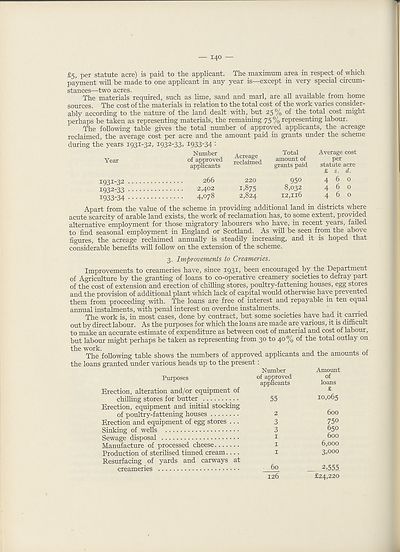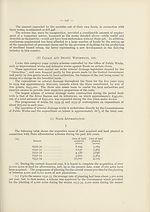Download files
Complete book:
Individual page:
Thumbnail gallery: Grid view | List view

140
£5, per statute acre) is paid to the applicant. The maximum area in respect of which
payment will be made to one applicant in any year is—except in very special circum¬
stances—two acres.
The materials required, such as lime, sand and marl, are all available from home
sources. The cost of the materials in relation to the total cost of the work varies consider¬
ably according to the nature of the land dealt with, but 25 % of the tptal cost might
perhaps be taken as representing materials, the remaining 75 % representing labour.
The following table gives the total number of approved applicants, the acreage
reclaimed, the average cost per acre and the amount paid in grants under the scheme
during the years 1931-32, 1932-33, 1933-34 :
Number
Year of approved
applicants
1931- 32 266
1932- 33 2,402
1933- 34 4.078
Acreage
reclaimed
220
I.875
2,824
Total
amount of
grants paid
950
8,032
I2,Il6
Average cost
per
statute acre
£ 5. d.
460
460
460
Apart from the value of the scheme in providing additional land in districts where
acute scarcity of arable land exists, the work of reclamation has, to some extent, provided
alternative employment for those migratory labourers who have, in recent years, failed
to find seasonal employment in Kngland or Scotland. As will be seen from the above
figures, the acreage reclaimed annually is steadily increasing, and it is hoped that
considerable benefits will follow on the extension of the scheme.
3. Improvements to Creameries.
Improvements to creameries have, since 1931, been encouraged by the Department
of Agriculture by the granting of loans to co-operative creamery societies to defray part
of the cost of extension and erection of chilling stores, poultry-fattening houses, egg stores
and the provision of additional plant which lack of capital would otherwise have prevented
them from proceeding with. The loans are free of interest and repayable in ten equal
annual instalments, with penal interest on overdue instalments.
The work is, in most cases, done by contract, but some societies have had it carried
out by direct labour. As the purposes for which the loans are made are various, it is difficult
to make an accurate estimate of expenditure as between cost of material and cost of labour,
but labour might perhaps be taken as representing from 30 to 40 % of the total outlay on
the work. . ,
The following table shows the numbers of approved applicants and the amounts ol
the loans granted under various heads up to the present :
Number
Purposes
Erection, alteration and/or equipment of
chilling stores for butter
Erection, equipment and initial stocking
of poultry-fattening houses
Erection and equipment of egg stores ...
Sinking of wells
Sewage disposal
Manufacture of processed cheese
Production of sterilised tinned cream....
Resurfacing of yards and carways at
creameries
of approved
applicants
55
2
3
3
1
1
1
60
126
Amount
of
loans
£
10,065
600
750
650
600
6,000
3,000
2,555
£24,220
£5, per statute acre) is paid to the applicant. The maximum area in respect of which
payment will be made to one applicant in any year is—except in very special circum¬
stances—two acres.
The materials required, such as lime, sand and marl, are all available from home
sources. The cost of the materials in relation to the total cost of the work varies consider¬
ably according to the nature of the land dealt with, but 25 % of the tptal cost might
perhaps be taken as representing materials, the remaining 75 % representing labour.
The following table gives the total number of approved applicants, the acreage
reclaimed, the average cost per acre and the amount paid in grants under the scheme
during the years 1931-32, 1932-33, 1933-34 :
Number
Year of approved
applicants
1931- 32 266
1932- 33 2,402
1933- 34 4.078
Acreage
reclaimed
220
I.875
2,824
Total
amount of
grants paid
950
8,032
I2,Il6
Average cost
per
statute acre
£ 5. d.
460
460
460
Apart from the value of the scheme in providing additional land in districts where
acute scarcity of arable land exists, the work of reclamation has, to some extent, provided
alternative employment for those migratory labourers who have, in recent years, failed
to find seasonal employment in Kngland or Scotland. As will be seen from the above
figures, the acreage reclaimed annually is steadily increasing, and it is hoped that
considerable benefits will follow on the extension of the scheme.
3. Improvements to Creameries.
Improvements to creameries have, since 1931, been encouraged by the Department
of Agriculture by the granting of loans to co-operative creamery societies to defray part
of the cost of extension and erection of chilling stores, poultry-fattening houses, egg stores
and the provision of additional plant which lack of capital would otherwise have prevented
them from proceeding with. The loans are free of interest and repayable in ten equal
annual instalments, with penal interest on overdue instalments.
The work is, in most cases, done by contract, but some societies have had it carried
out by direct labour. As the purposes for which the loans are made are various, it is difficult
to make an accurate estimate of expenditure as between cost of material and cost of labour,
but labour might perhaps be taken as representing from 30 to 40 % of the total outlay on
the work. . ,
The following table shows the numbers of approved applicants and the amounts ol
the loans granted under various heads up to the present :
Number
Purposes
Erection, alteration and/or equipment of
chilling stores for butter
Erection, equipment and initial stocking
of poultry-fattening houses
Erection and equipment of egg stores ...
Sinking of wells
Sewage disposal
Manufacture of processed cheese
Production of sterilised tinned cream....
Resurfacing of yards and carways at
creameries
of approved
applicants
55
2
3
3
1
1
1
60
126
Amount
of
loans
£
10,065
600
750
650
600
6,000
3,000
2,555
£24,220
Set display mode to:
![]() Universal Viewer |
Universal Viewer | ![]() Mirador |
Large image | Transcription
Mirador |
Large image | Transcription
Images and transcriptions on this page, including medium image downloads, may be used under the Creative Commons Attribution 4.0 International Licence unless otherwise stated. ![]()
| League of Nations > Communications and transit > Enquiry on national public works > (142) |
|---|
| Permanent URL | https://digital.nls.uk/195000196 |
|---|
| Shelfmark | LN.VIII |
|---|
| Description | Over 1,200 documents from the non-political organs of the League of Nations that dealt with health, disarmament, economic and financial matters for the duration of the League (1919-1945). Also online are statistical bulletins, essential facts, and an overview of the League by the first Secretary General, Sir Eric Drummond. These items are part of the Official Publications collection at the National Library of Scotland. |
|---|---|
| Additional NLS resources: |
|

